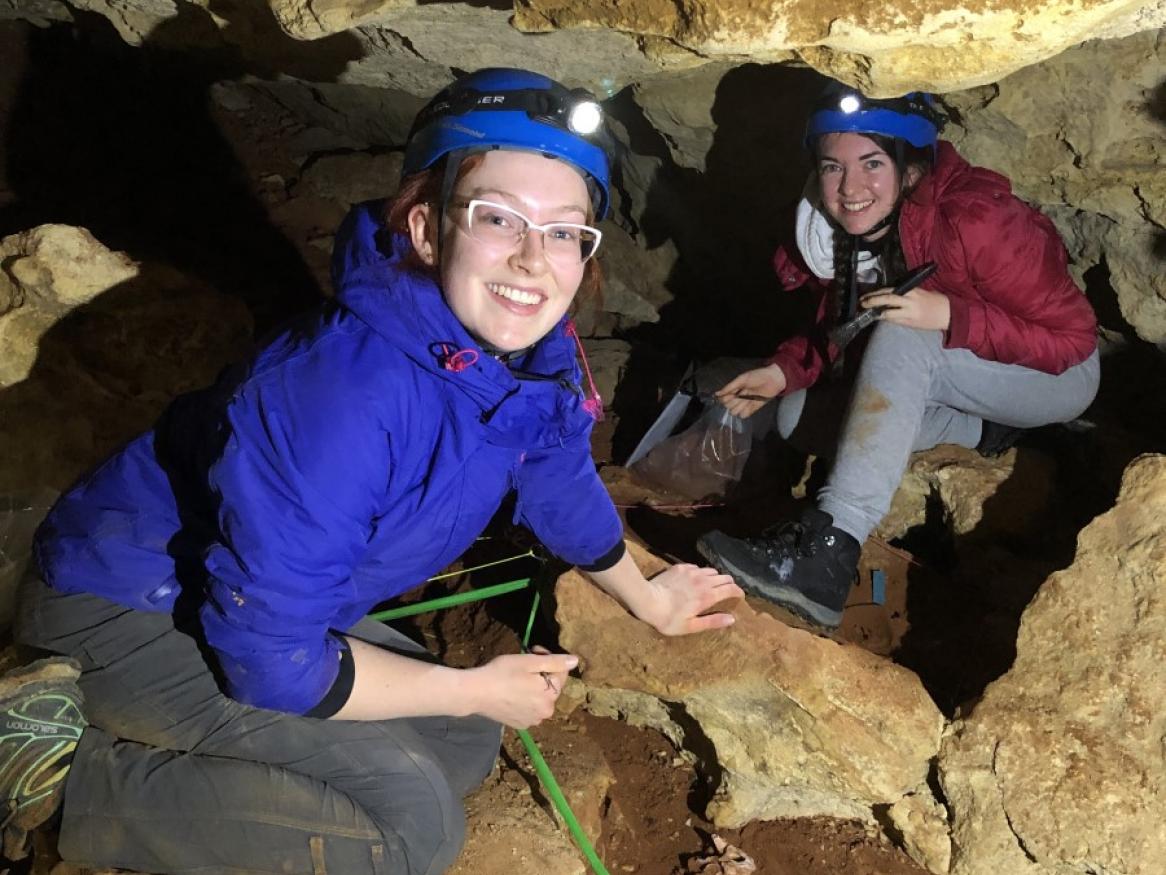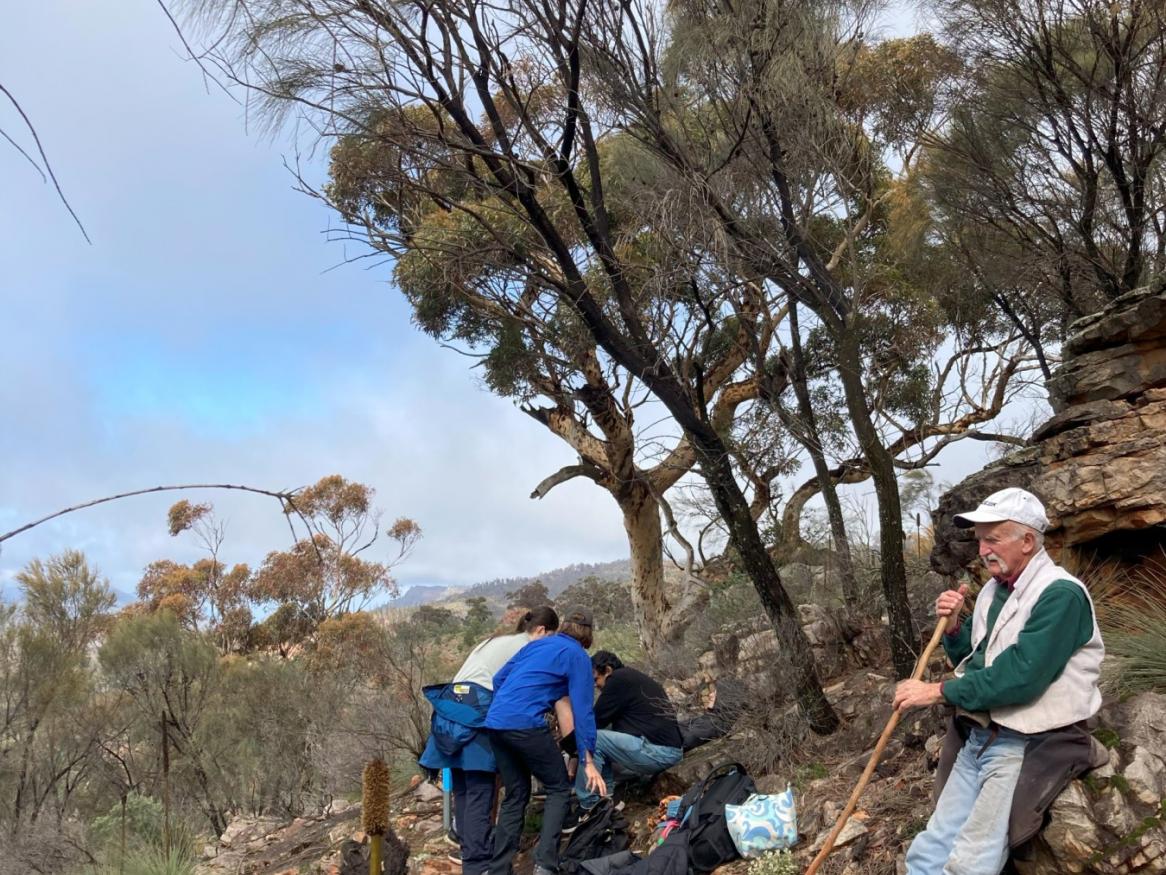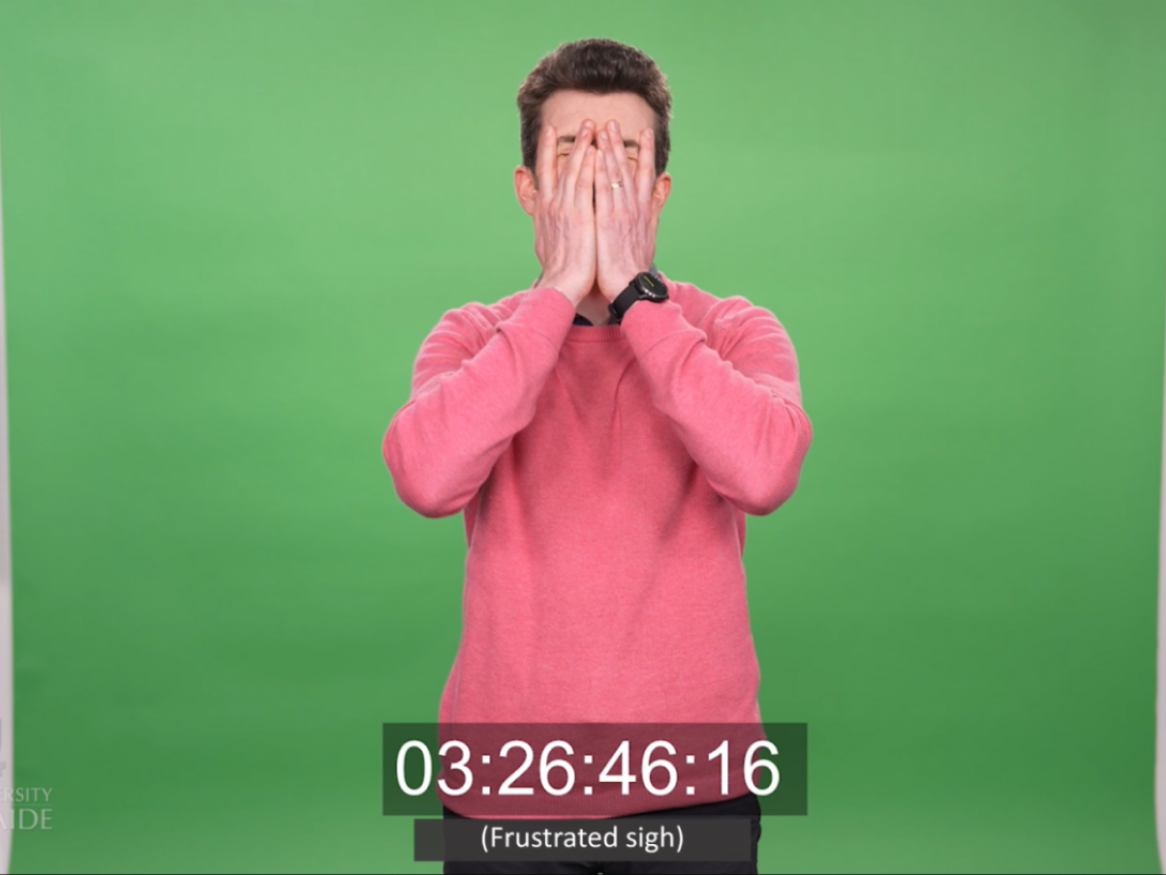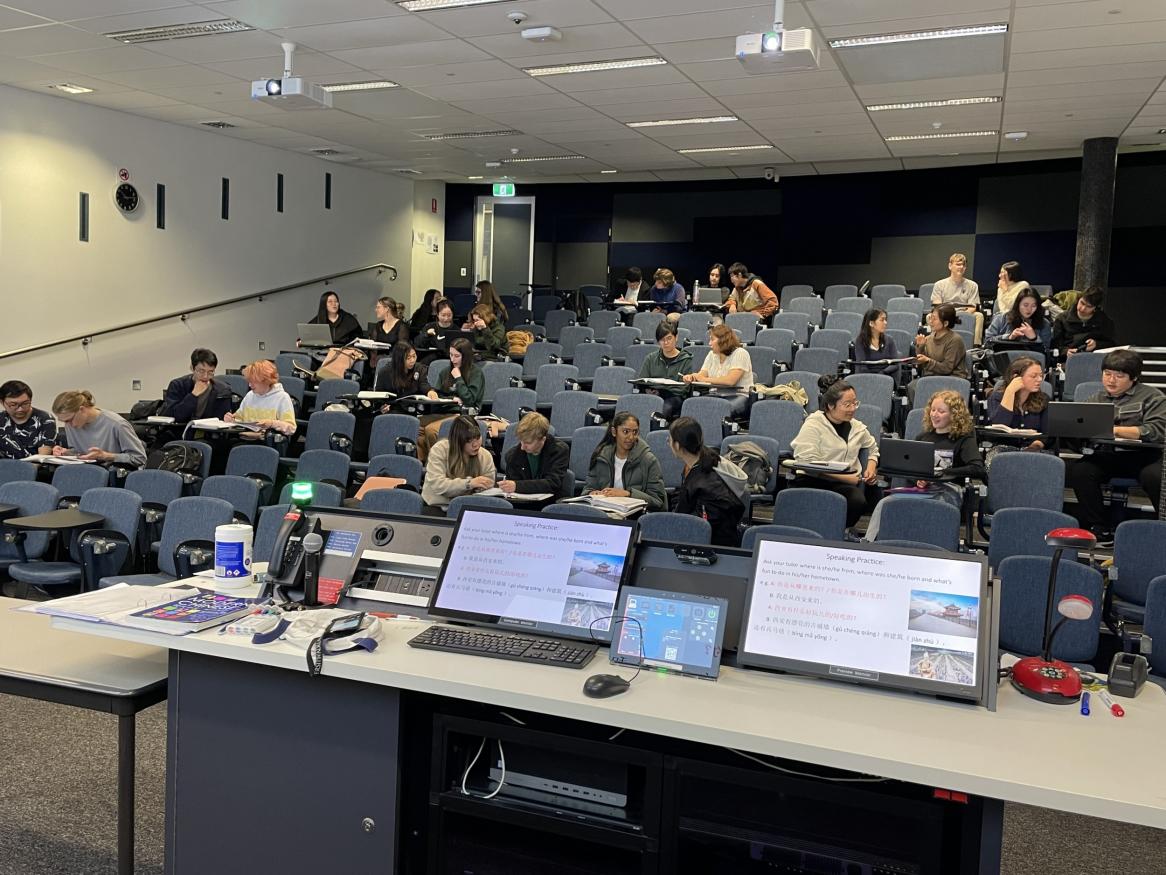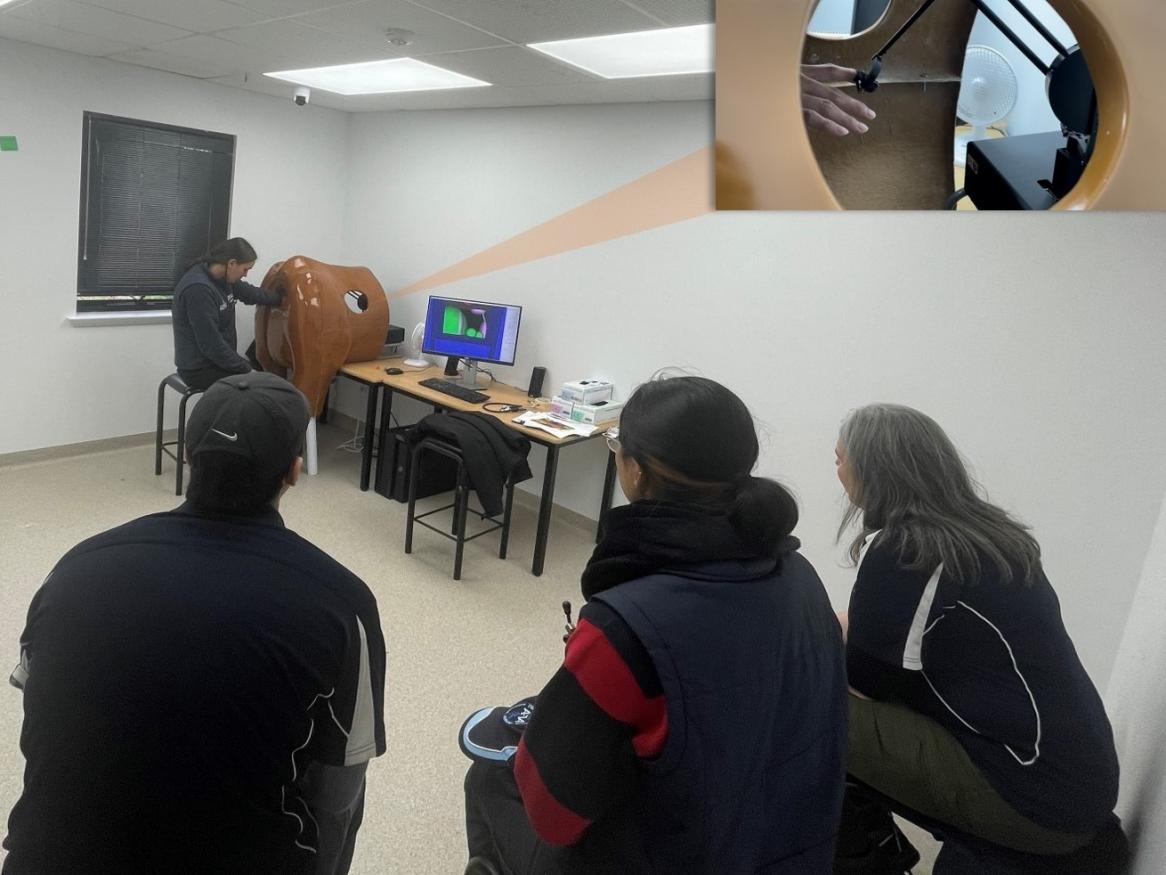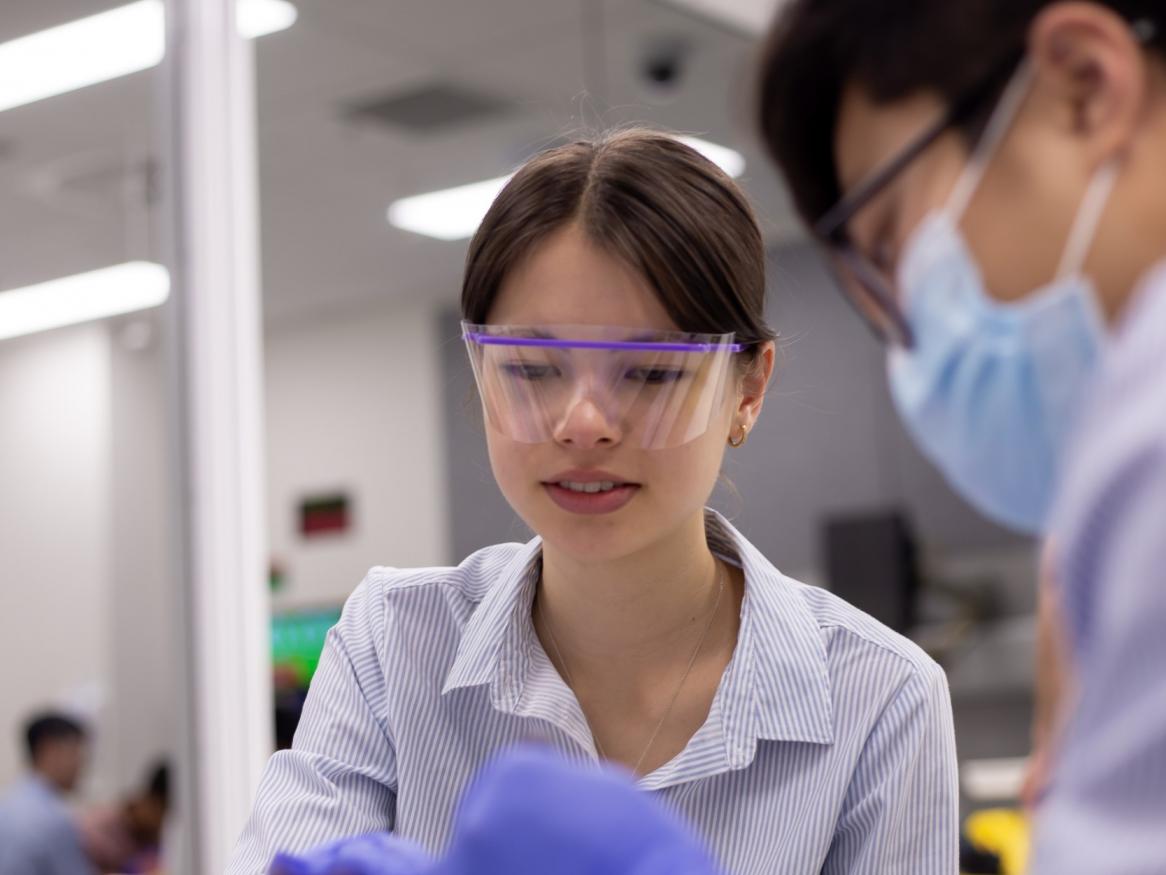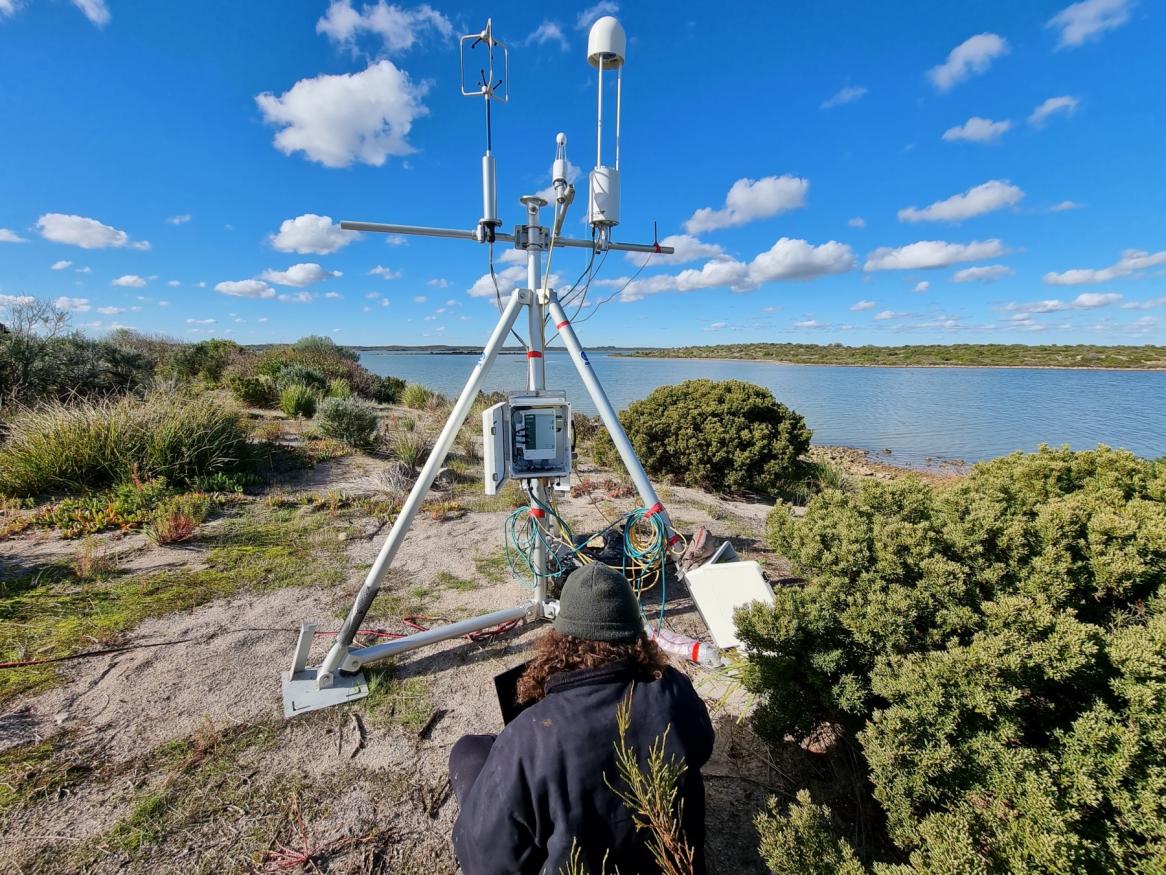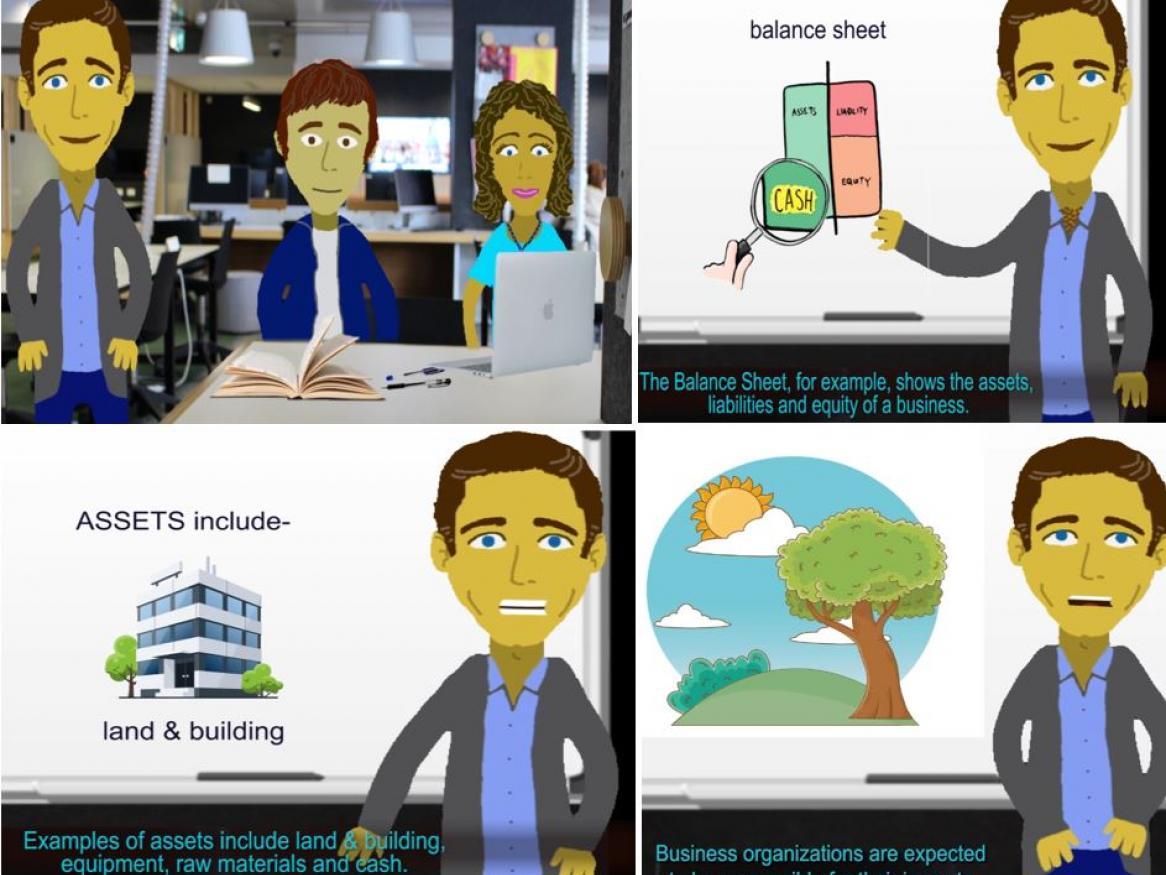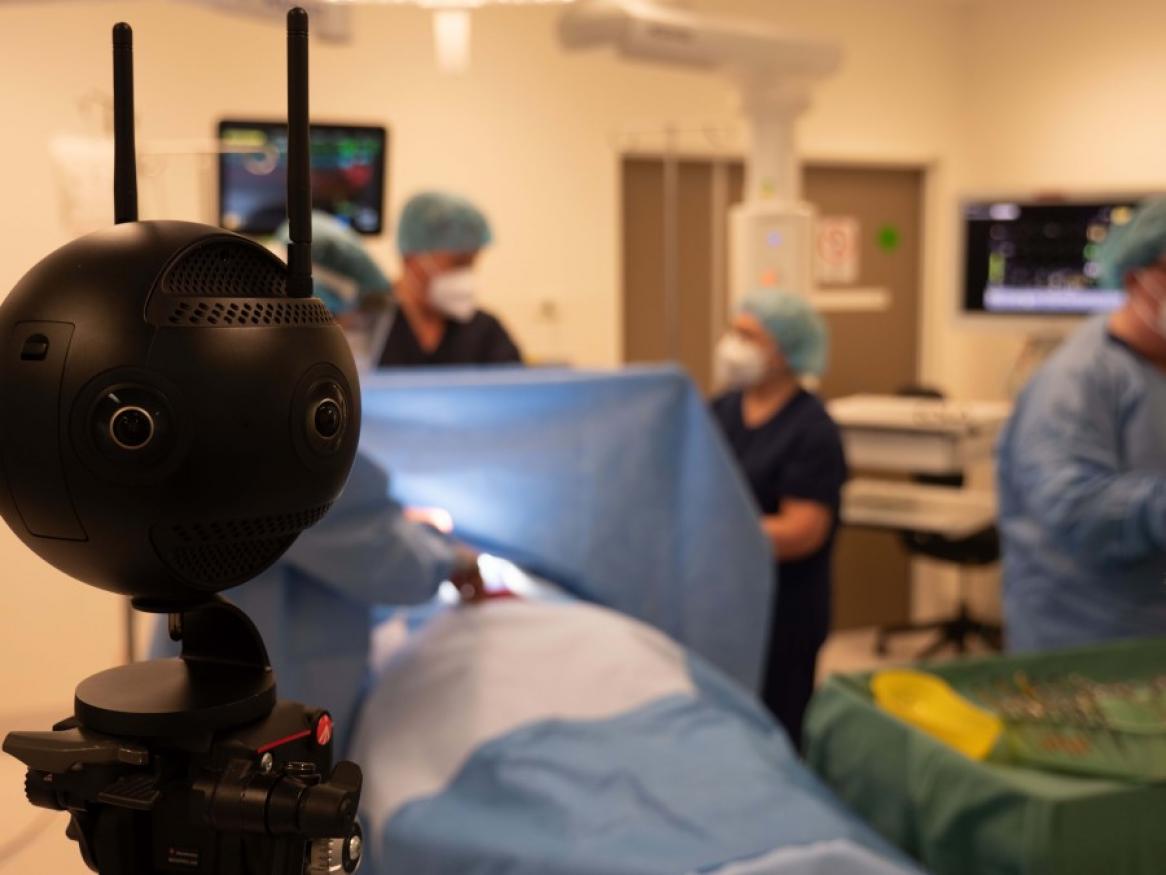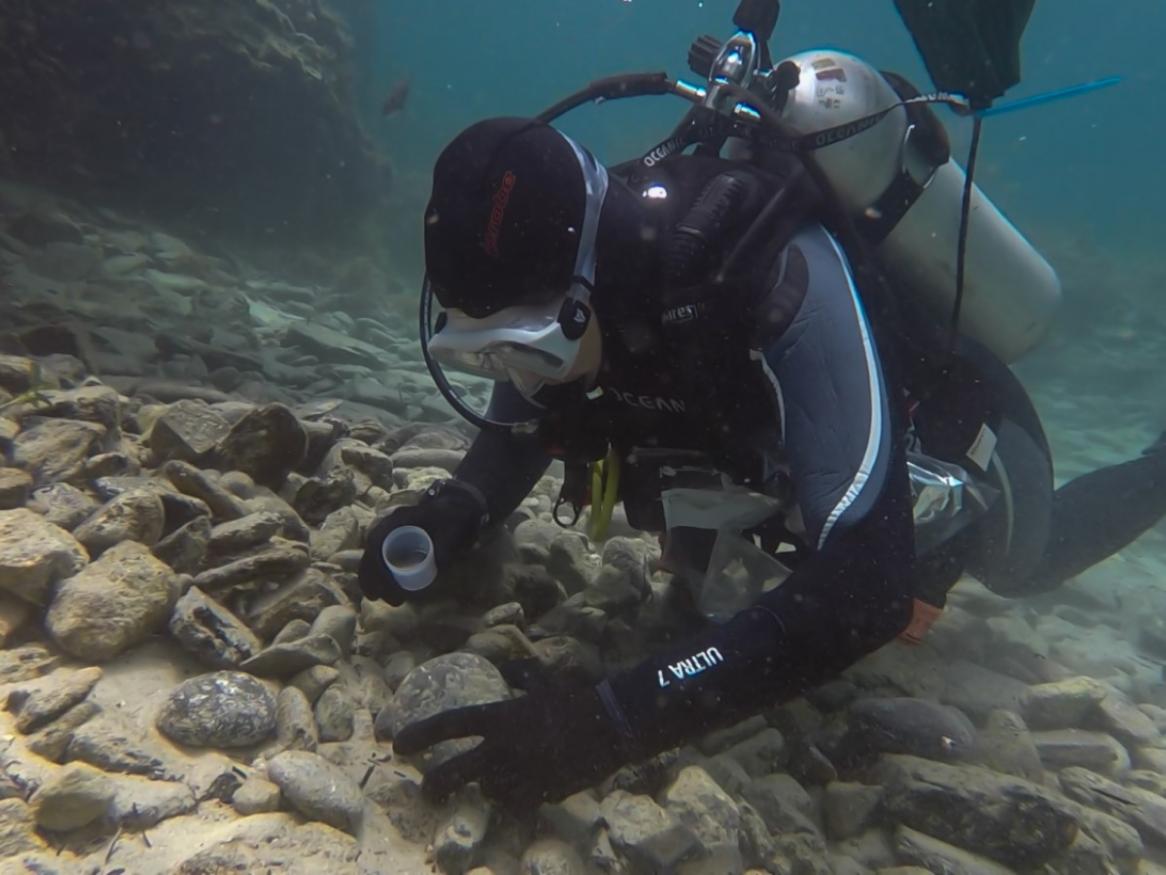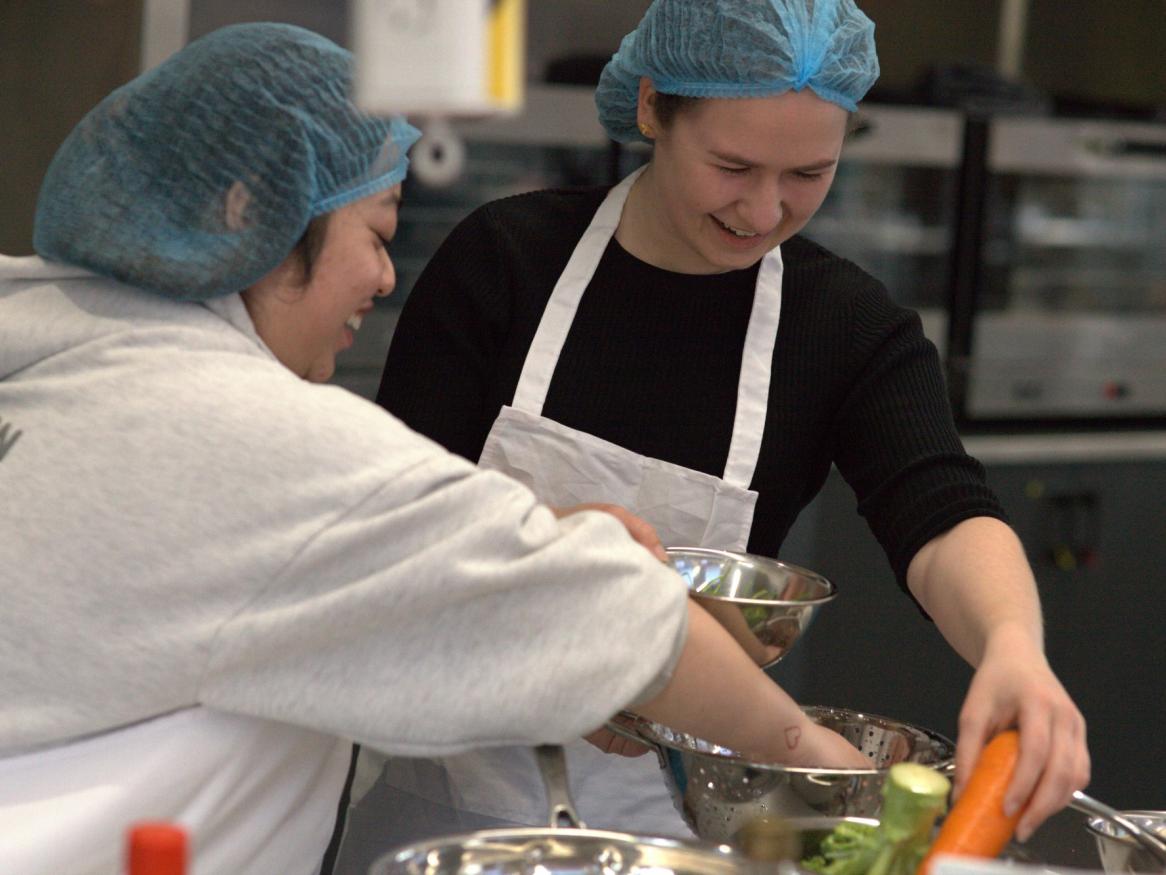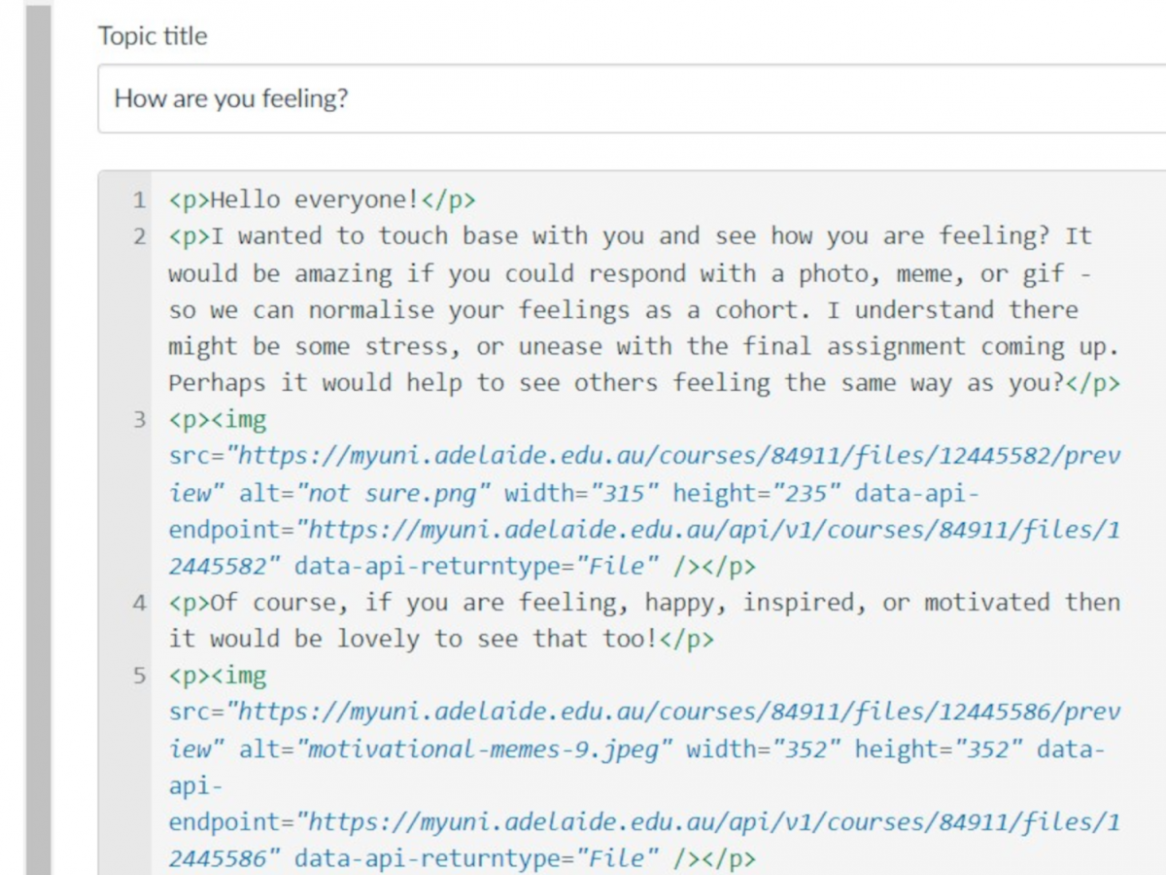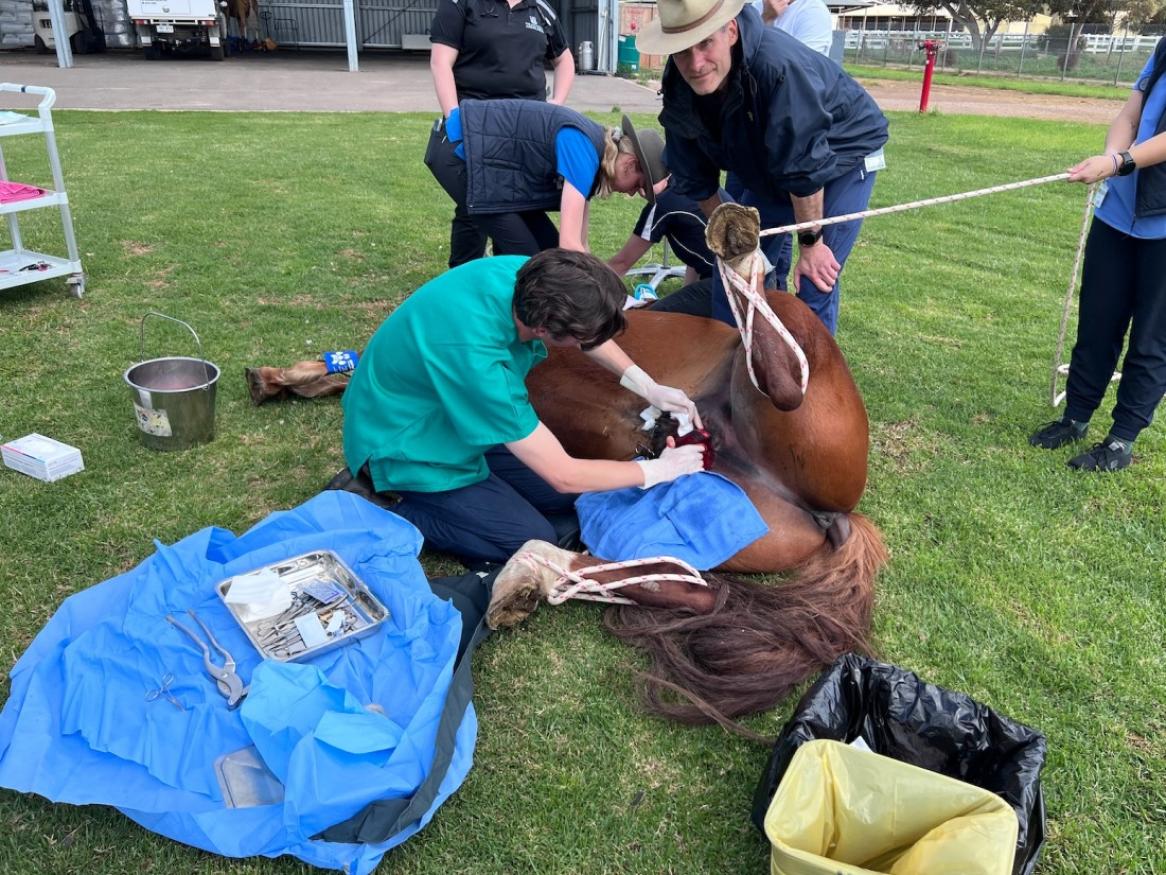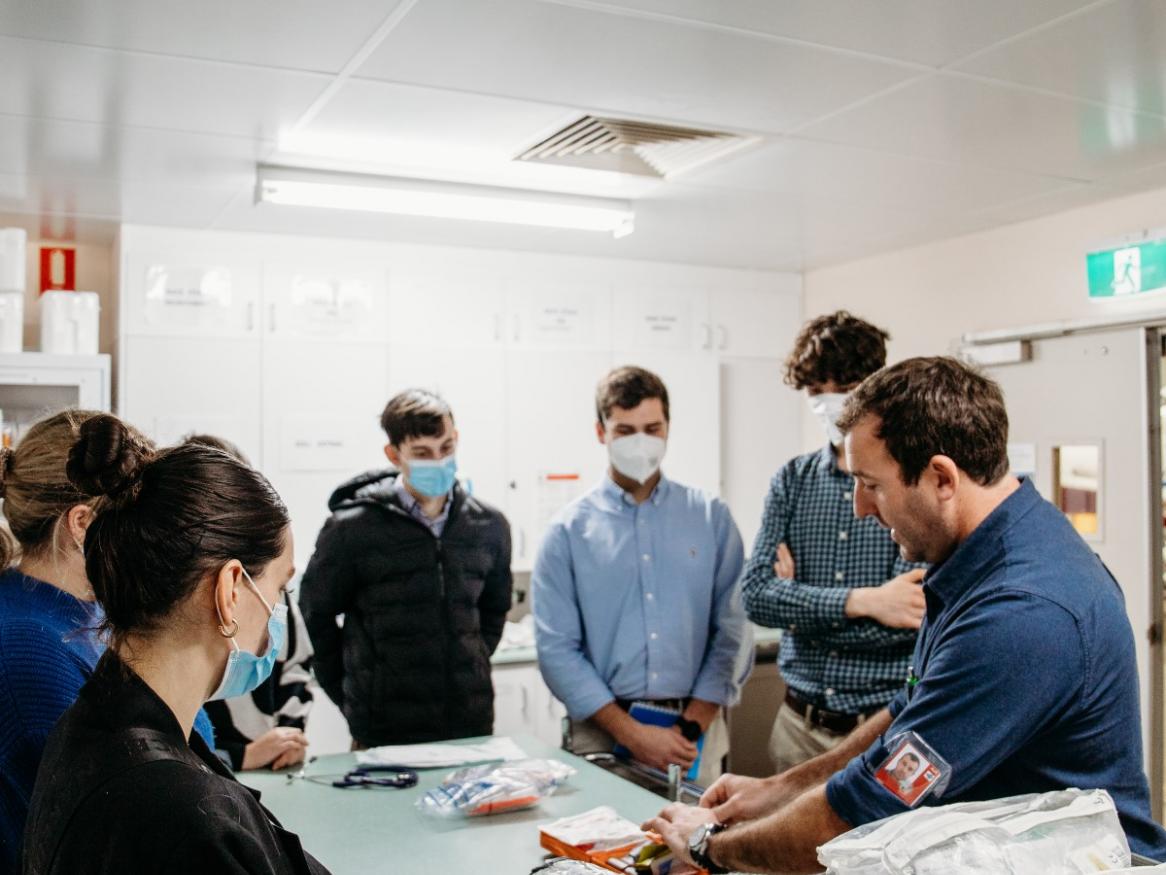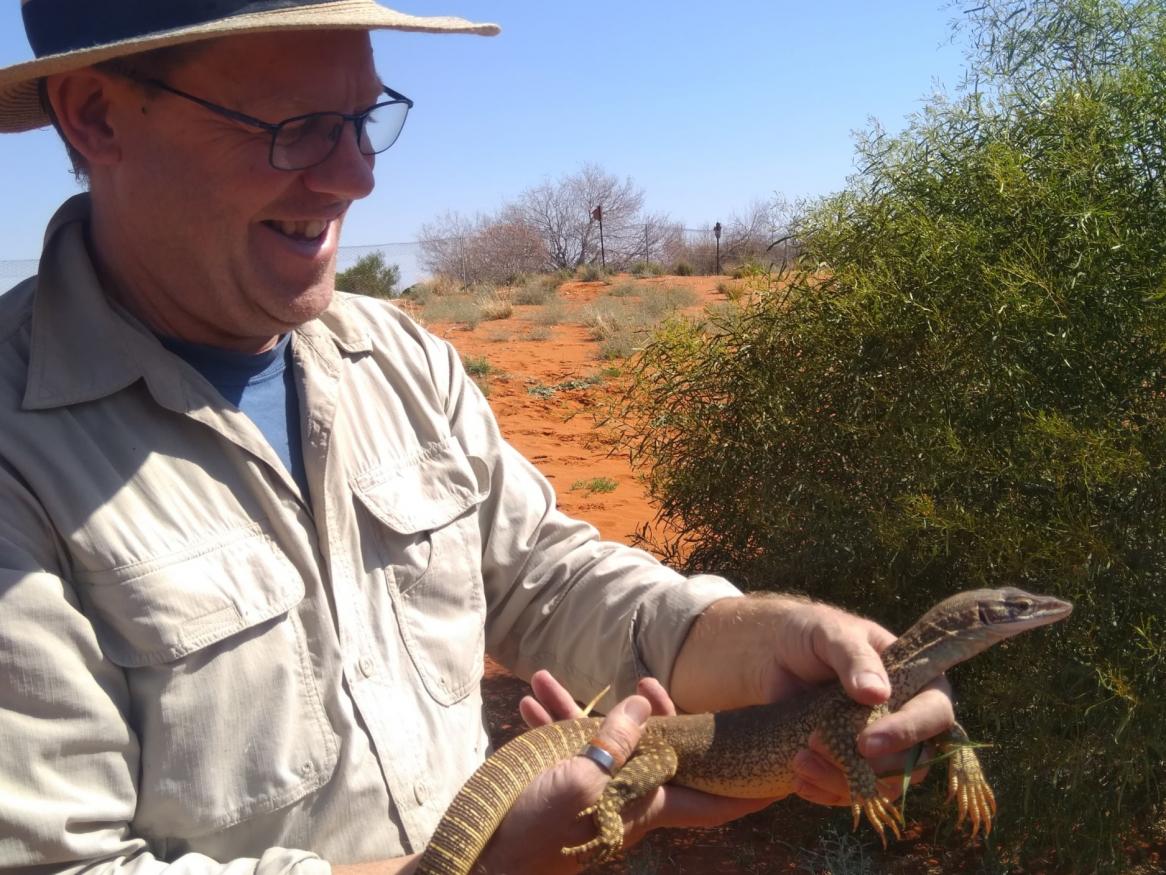2023 submissions showcase
Dr Liz Reed - First Prize
The thrill of discovery
My passion for caves and palaeontology started with an undergraduate field camp to the Naracoorte Caves. In the Fossil Cave I was given the opportunity to excavate in a real dig and I uncovered the jaw of an extinct kangaroo that died over 200,000 years ago. At the time I realised that I was the first human being to see that fossil. My first palaeontology experience has stayed with me ever since and started my career as a scientist.
I see the same thrill of discovery in the faces of Rachel Atkins and Rhianna Power, pictured here excavating 78,000-year-old megafauna fossils in a cave at Naracoorte during our Field Palaeontology course. In our field courses the students work side by side with researchers from a variety of disciplines from palaeontology and geochronology to ancient DNA. Innovation in our teaching comes from this multi-disciplinary approach that gives the students a broad, hands-on experience in the palaeosciences. This encourages them to find their own niche in this exciting field.
Rachel Atkins is currently working on a PhD in palaeobotany, studying macroplant fossils from Naracoorte Caves. She has already published two papers on her work. Rhianna Power completed an Honours degree involving dating and sediment analysis of megafauna deposits in a cave at Naracoorte. She also is an author on a recent publication.
Photo taken with iPhone with minor editing in the photos app.
Dr James Padley - Second Prize
Generations
In 2022, seven students were selected to take part in an innovative teaching program at the Adelaide Rural Clinical School (ARCS) in Port Augusta. The program was gifted the name Kulpi Minupa, which translates as Cloud Doctor in the language of First Nations Nukunu people, who have their traditional lands around the Spencer Gulf. With the support of local partnerships and the Hoopman Education Fund, the students, who were in their second year of studies, were able to live full time in Port Augusta whilst undertaking all of their classes locally. Local doctors from the Flinders and Far North Doctors Association (FFNDS), together with the clinical school, organized a camp and hike, that formed part of the educational and social experience. The hike was based in the Dutchmen’s Stern Conservation Park, at the southern end of the Flinders Ranges, just outside the local township of Quorn.
The photo captures a memorable moment on the hike. Pictured in the background are local doctors, Dr Jess Martyn, and Dr Kalpesh Lad, who are helping students tackle a simulated emergency scenario – a brown snake bite. You can see one of the students lying on the ground looking relatively calm as the simulated patient! In the foreground, leading the scenarios, is Dr Tony Lian-Lloyd, who is captured in a moment of reflection and contemplation. Although recently retired from clinical practice, Tony was the local GP in Quorn and has faithfully serviced the community for over 30 years, as well as providing anaesthetic services at the Port Augusta hospital. Throughout his career, Tony has been committed to teaching and has undoubtedly influenced generations of medical students and junior doctors.
At its heart, learning medicine is an inter-generational artform. We rely on our elders passing on their skills and knowledge, and more importantly, the wisdom of their experiences. This photo, showing many generations learning from each other, captures the very essence of teaching and learning in Kulpi Minupa. As an innovative program of ARCS and the Adelaide Medical School, we are committed to developing rural training opportunities, where students can live and learn in a place that enables them to grow as individuals within a supportive community.
Dr Mandi Carr - Third Prize
The VR cattle handling experience
Mixed reality technology has become more accessible for students at the Roseworthy Campus within the last 12 months with the introduction of a Virtual Reality (VR) cattle handling experience.
‘The VR cattle handling experience is the only one of its kind in the world’, according to Dr Mandi Carr, Large Animal Clinician and Lecturer at the School of Animal and Veterinary Sciences who developed the experience.
All first year students enrolled in the four degrees offered at Roseworthy have a virtual cattle handling experience prior to undertaking live cattle practicals.
‘The VR cattle handling experience is designed to help students feel more comfortable around cattle, experience the size of cattle and how they move so that in the paddock or in the yards, they can move real cattle confidently and in a safe way; explains Dr Carr.
The students learn about flight zones (the personal space or comfort zone) of an animal and that when they encroach into that flight zone, the animal moves away. Using the flight zone, they can move animals in a certain direction and even safely move an animal away from others in the mob. The live cattle practical builds on the VR experience by putting into practice what they have learned
Richard McInnes - Highly Commended Award
Unscripted
Step into the behind-the-scenes chaos of the greenscreen studio with this photograph, where we see the subject striving for perfection in the midst of a high-pressure studio environment.
In the ever-evolving digital world, the boundaries between traditional and modern modes of learning are continually reshaped. Accustomed to engaging students in lectures and tutorials within the campus environment, this educator finds themselves facing a new modality—an intense and unforgiving camera lens. It serves as a stark reminder that the art of presenting in front of a camera demands a different skill set and level of flexibility.
This image encapsulates the dedication and perseverance required to thrive in the digital age of education. It serves as a testament to the commitment of educators who continuously explore innovative approaches, ensuring learners can navigate a rapidly changing educational landscape. The emotions conveyed by the individual's expression offer a profound glimpse into the challenges of the creative process, capturing a raw and authentic moment of frustration. Through the lens of this image, we are reminded that even in a world of polished presentations, it is our imperfections that truly connect us to the human experience.
Valerie Yung - Student Award and People's Choice Award
Why I leave for uni at 8am and come back after 9pm
My college friends often ask why I “leave for uni at 8am and come back after 9pm”. Well, here is some photographic evidence for you!
As second-year dental students, we have anatomy classes from 9am-12pm, simulation clinic from 1pm-4pm (as imaged), and head on over to the Adelaide Dental Hospital to see patients from 5pm-9pm.
“How do you manage to do this every week?” Spending time with my fellow not-yet dentist friends throughout the day, from filling teeth with amalgam to putting Triplaque ID dye on each other’s teeth, keeps me going throughout the semester.
I have also started to “vlog” some of this process to show everyone what we do on a daily basis, to ultimately become a tooth doctor. This photograph is a snippet of one of the “vlogs” of preparing a rubber dam to prepare an upper left molar cavity, which we later filled with composite resin. Exciting!
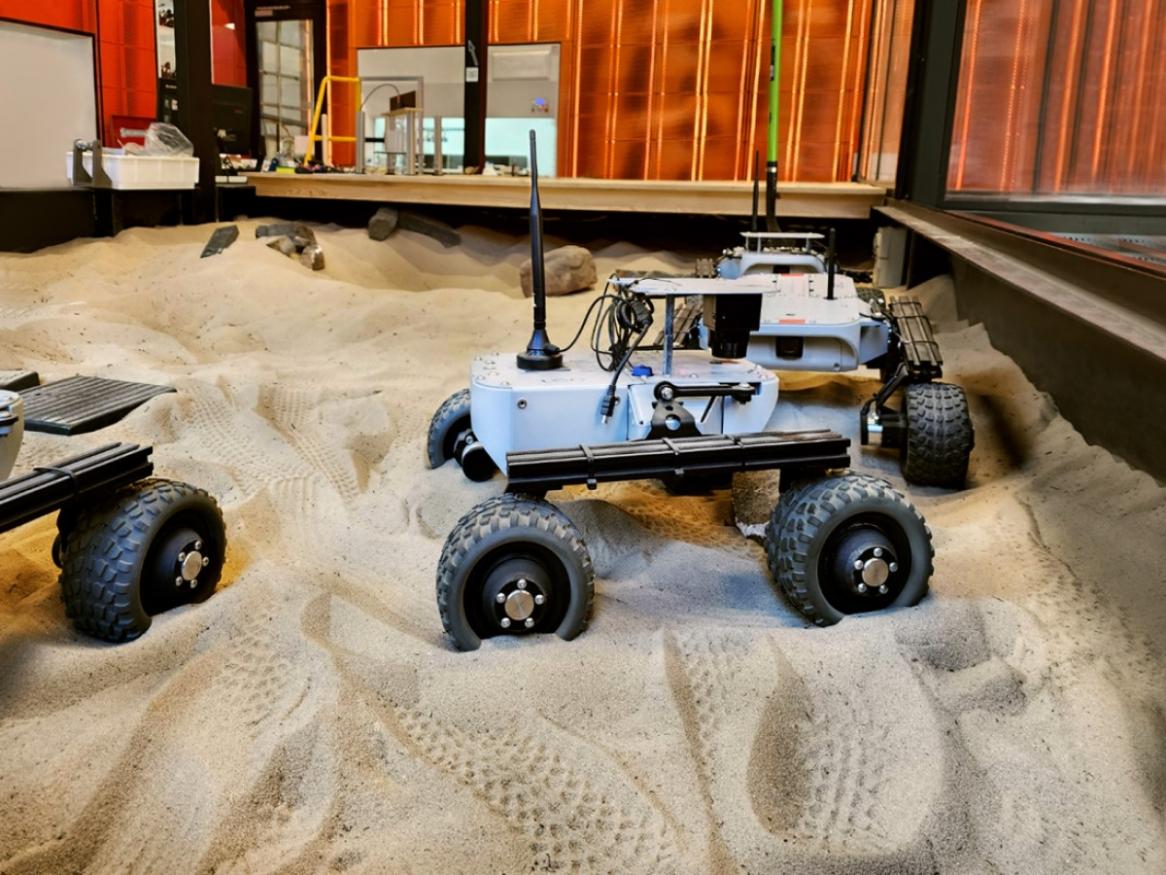
Akshay Kumar Agarwal
Extraterrestrial Lab at the University of Adelaide
This photo that captures the spirit of creativity in teaching and learning, as well as the university's pioneering position in space exploration, can be found in the Extraterrestrial Lab at the University of Adelaide. The picture shows a rover hovering above a simulant of lunar regolith, which is a moment of stunning significance.
This amazing image represents a new era in how the University trains and educates the upcoming generation of space scientists and engineers. The University of Adelaide is encouraging a culture of experiential learning while embracing the difficulties and possibilities of interplanetary exploration. Students here don't simply learn about space missions; they design, build, and operate their own rovers, precisely like the one in the picture, using cutting-edge technology and research.
The sand, resembling the lunar surface, serves as an extraterrestrial environment where students apply their knowledge in real-world scenarios. It reflects the university's commitment to creating a dynamic environment where innovation thrives, and where students learn through practical experience.
Using tools like Adobe Photoshop, this photo was carefully adjusted to improve the lighting and clarity while highlighting the dramatic interaction of light and shadow. This photograph serves as a tribute to the University of Adelaide's unwavering commitment to advancing human knowledge in preparation for the upcoming space missions that will define our future among the stars by recognising innovation in learning and teaching.
David Butler
Maths Learning Centre guest workshop on statistics
For the course Foundations in Research (Marine & Wildlife Conservation), the course coordinator asked the Maths Learning Centre to provide a guest workshop introducing statistics concepts so that learners could begin to think about using data to display and investigate relationships. Since statistics is usually performed using a computer, it can feel unreal to learners, and can also separate them from each other as each learner is looking at their own screen. To counteract these difficulties, I designed a workshop centered around groups sorting and arranging data using cards in physical space. The data cards were made by collating information on the 46 different kinds of mammals that live at Adelaide Zoo, which I thought was appropriate to the cohort studying this course. In the image you can see the hands of seven learners at a moment when they were deeply engaged, working together to make sense of data using the cards.
Hong Cai
Meeting Multilingual Minds initiative
This picture showcases the Meeting Multilingual Minds initiative in action. This initiative provides an authentic and immersive learning environment for both domestic students who are learning Chinese as a foreign language and international students who are learning English as a foreign language. It supports the social inclusion and cultural integration of international students and enhances student experiences across disciplines.
This picture was recently taken in a first-year Chinese language class, where learners of Chinese as a foreign language (mainly domestic students) were practising Chinese with native speakers (mainly international students). These native speakers are current international Chinese students who were recruited through the Volunteer Tutors Program featured on the website.
Through semi-structured interactive activities, both cohorts can build their cultural intelligence, improve their communication skills, and make friends.
Gustavo Ferlini Agne
Haptic Horse Training in Veterinary Medicine
The University of Adelaide Roseworthy Veterinary Hospital treats every year hundreds of horses suffering from abdominal discomfort, a disease process also known as colic and one of the most common clinical conditions seen in horses. A crucial step in the examination of horses suffering from colic is the transrectal examination which allows veterinarians and veterinary students to further define a possible cause for the colic, but significant practice is required to appropriately perform the procedure.
In an Australian first, the SAVS has recently acquired the Haptic Horse, a high-fidelity robotic simulator that students can use to practice transrectal examinations. The high-fidelity simulator uses both robotic and haptic technology to replicate the exact feeling and the shape of the various organs in the horse’s abdomen by stimulating tactile sensations. Students are initially exposed to the Haptic Horse for practicing transrectal palpation in a safe environment prior to performing the procedure in live animals. This educational approach is beneficial for the lecturer, the student and for the animal welfare. The technology allows students to practice with the horse’s normal internal anatomy but also simulates the various abnormalities that occurs in horses with colic.
This innovation in teaching allows our future veterinarians to improve proficiency for this clinical skill, further expanding the ability to recognize and treat the different types of colic in horses. The implementation of the Haptic Horse technology in the Doctor of Veterinary Medicine curriculum reinforces our commitment to delivery of the latest technological innovations in veterinary education.
Software used to edit the photograph: PowerPoint
Frank Grutzner
Colouring in the human genome
Fundamental insights in genetics have been able due to the ability of DNA sequences to bind complementary sequences in a so-called hydridisation experiment. This technique is used to identify disease genes, map genes in the genome and even to see if genes are turned on or off.
In our 3rd year genetics practical students use this technique to detect human X and Y sex chromosomes on slides resulting in visually appealing colourful pictures (see submiGed picture) where the human chromosome set is stained in blue and the X and Y chromosome in green and red. In addition, this technique also allows localisation of the X and Y chromosome in the nucleus (the blue circle on the right-hand side with the green and red dots).
In this practical we apply our philosophy to inspired through research led teaching. This technique is state of the art molecular cytology used in research and diagnostic laboratories and in order to take the pictures students have an opportunity to use high end research fluorescence and confocal microscopy in Adelaide Microscopy. We try to get the students as close as possible to experience research by doing a state-of-the-art experiment and immersing them in the School of Biological Sciences research environment. Student evaluation regularly highlights the practicals as the best part of the course.
Due to the visual appeal this image served as template for a new wallpaper design on display in the MLS Adelaide Microscopy Facility.
Acknowledgements: We are grateful for the support of the Womens and Childrens Hospital Cytology unit for providing high quality human metaphase slides and Adelaide Microscopy staff to assist with the use of the high-end research microscopes and our students, teaching support staff, and demonstrators for conducting the experiment.
Emma Hale
AHMS Academics in Action
Working to a strict timeframe of rotating 4th year medical students, Academic staff at the Adelaide Health and Medical School Simulation Labs are on the clock to impart practical knowledge to attentive learners. Providing a brief to each cohort and supervising their practical application in suturing, securing an ABG, inserting Nasogastric Tubes and monitoring a blood transfusion patient are all in a day’s work.
Providing a realistic working environment for students to practice and apply their theoretical knowledge in a low-risk environment develops confidence ahead of navigating the high pace hospital environment as they commence their internships on the ward.
I used Lightroom Classic to lightly edit the colour, tone, and light of the image.
Christopher Keneally
Matilda Southgate setting up an automated eddy flux tower
Honours student Matilda Southgate setting up an automated eddy flux tower to measure atmospheric greenhouse gas concentrations in the Coorong National Park in June of 2021. Prior to this, Matilda completed an undergraduate degree in the School of Biological Sciences, she is very driven and largely self-directed, and the research outputs of her very innovative honours went on to be included in government reports and peer-reviewed publications, directly informing environmental policy and management. Matilda now works more directly with government, for the Murray-Darling Basin Authority in Griffith.
Rachelle Kernen
Flinders Ranges Stromatolites
Stromatolites are layered sedimentary structures formed by the growth of microbial communities, mainly cyanobacteria (blue-green algae), in shallow water environments. They are some of the earliest evidence of life on Earth and can provide valuable insights into the planet's ancient environments. In the Flinders Ranges of South Australia, stromatolites play a significant role in understanding the region's geological and paleontological history.
Mahmud Masum
Animated cartoon videos developed to inspire students to engage in active learning
Animated cartoon videos were developed to inspire students to engage in active learning. The innovation lies in the use of lip-synchronised dialogue by an animated expert character, who interacts with two student characters. Throughout the sequence of videos, the student characters make connections to previous learning that implicitly encourages the viewer to do the same. The animated videos provide signalling cues (arrows and colour highlighting) to emphasise important concepts, as well as visual impressions that correspond to relevant business environments (e.g., factory floor, manufacturing process, and buildings). The accounting expert and student characters engage in discussions about accounting concepts, rather than limiting the dialogue to a question-answer session. Design modifications, including new characters and substantially revised scripts, were made based on student feedback.
This approach has led to a sense of co-creation between staff and students. The innovations are implemented across several courses and programs within the Adelaide Business School. Survey results provide strong evidence that the animations improved students’ learning experience. Students made the following observations in focus group discussions:
‘The animated videos are incredibly helpful in keeping me engaged with the course through the humour and relatable characters, while also providing in-depth information regarding concepts.’
‘A lot of times, I would sort of pause the video when the person asked the question and try and answer it myself before the expert says something…..it was helpful for me.’
‘I love this (videos)! The questions are really on the money, especially the way they answered the questions.’
Paul McLiesh
360-degree video resource created by Adelaide Health Simulation and the Adelaide Nursing School
This image depicts a 360 degree video resource created by Adelaide Health Simulation and the Adelaide Nursing School and is designed to prepare nursing students for a clinical placement in the operating room.
The video is an immersive experience that helps nursing students better understand a challenging setting by familiarising them with the design of the theatre space, the sterile things in the room, the people and their roles. It also provides a video from the patient’s view entering the theatre, lying on a bed. This provides the student with an insight of what its like from the patients’ perspective.
Lachlan McLeod
Embark on a voyage into the world of marine ecology
Embark on a voyage into the world of marine ecology alongside Erin, a dedicated member of the University of Adelaide community. In this captivating photograph, Erin leads the way as she collects samples, shedding light on the critical issue of ocean acidification.
This image beautifully exemplifies the strong sense of unity and innovation within our university. Teamwork is the cornerstone of the marine science research, as we dive into the mysteries of the ocean, we symbolise the collaborative spirit that defines the University of Adelaide. This community-driven approach to learning and teaching inspires groundbreaking discoveries and pushes the boundaries of knowledge.mThe photograph showcases the impact we can achieve when we come together to explore and understand our environment.
Let’s celebrate this remarkable journey within the marine sciences and the entire University of Adelaide community's dedication to fostering curiosity, driving innovation, and shaping a brighter future for our planet.
Sally Morris
Innovation in teaching in speech pathology practice
This photo represents the outcome of innovation of teaching in speech pathology practice. Historically, the teaching of mealtime practices and dysphagia has been in a lecture hall, via slides, videos, a tub of diced peaches, and Jatz crackers. Our vision was to change the face of speech pathology teaching in SA through integrated self-reflection, meaningful and realistic workshop content, and hands on experiences.
Commencing delivery in 2021, our Program took an integrated spiraled approach to curriculum development, and an interprofessional, culturally aware approach to our delivery. From day 1, students have immersive experiences highlighting the integral role of mealtime practices in identity and connection to culture. We consider this concept on a global scale, reflecting how small changes to our deep-rooted practices can influence our wellbeing and health outcomes. We bring the students from the walls of the classroom into the beautiful Waite Campus kitchens with an accredited Dietitian to explore the sensory properties of food, starting their interprofessional learning from their career beginnings.
A 3rd Year sister practical has been developed focusing on dysphagia. Students explore the industry space with accredited speech pathologists and a dietitian. Students lead the modification of food textures and aged care menus, reflecting on the sensory and nutritional properties of their menu. Students develop and cook textured modified recipe that aligns with the IDDSI Standards and is balanced against the Australian Guide to Healthy Eating, providing real life experience of the challenges faced in the space of modified diet prescription.
Dr Samantha Newell
Online teaching is all about connecting
I teach into the fully-online Graduate Diploma in Psychology. Most of the time, I am communicating with my students asynchronously. This can increase Transactional Distance between the student and the teacher. As such, I employ several strategies to connect with our learners. One approach is to reach out to students and ask them how they are feeling (as they approach the major assessment deadline). I embed small actions like this as my teaching philosophy is based on a Pedagogy of Care.
The human element is even more important in our fully-online courses, so this image reflects my effort to connect across the technological divide.
Erik Noschka
Equine Castration Field Day
Veterinary students in their sixth year have the opportunity to conduct a realistic field drop of a horse, run their own anaesthesia and perform the castration procedure independently. The lawn is located adjacent to the teaching hospital and staff members are in close proximity to supervise and encourage this practice ready approach, while potentially anxious horse owners don't interfere with the confidence building and relaxed environment.
Jessica Ryall
A virtual rural Emergency Department (ED)
Medical students are given a unique opportunity through the Adelaide Rural Clinical School to participate in placements across rural South Australia and Broken Hill. Within the context of the longitudinal year 5 rural placement, an enriching experience awaits as all rural students and staff converge for a week-long immersive workshop in Port Pirie.
During this intensive week, students are transported into a virtual rural Emergency Department (ED) where they collaboratively engage in small groups to manage simulated patients who present to the ED. It is a realistic learning experience, that allows students to practice and make mistakes in a safe and well-supported environment.
In this image, Amos Lee, a 5th year medical student, is talking with a simulated patient played by Lizzy Falleland.
Ulrike Schacht
Scanning Electron Microsopy (SEM) image of a sandstone sample
This image displays a scanning electron microscopy (SEM) image of a sandstone sample stemming from Otway Basin, South Australia. The image displays secondary mineral precipitates that have formed as the result of sediment burial and the prolonged exposure to diagenetic processes such as primary mineral dissolution and secondary mineral precipitation. These diagenetic changes occur over a duration of millions of years, and as the scale bar suggests (20 um), on the smallest of scales.
It is critical for geologists and subsurface engineers to be able to identify and understand microscopic changes like these, as they directly influence fluid flow, and the capacity of geological subsurface formations to store and hold essential resources such as groundwater, or renewable energy resources in the form of hydrogen. An accurate knowledge of these features enables us to identify and optimize the use of these resources.
Introducing students to electron microscopy caters for multiple learning styles simultaneously. On one hand it allows students to engage directly with a cutting-edge piece of technology. On the other hand, it provides a (visually captivating) learning experience that has the potential to make complex concepts in the fields of geology and subsurface engineering more accessible to students.
The original file format for this image was a TIF. I used Photoshop Elements to convert the image into a PNG file. Adelaide microscopy hosts the SEM machine used to obtain this image.
Kerry Steer
Kulpi Minupa
In 2022, seven students were selected to take part in an innovative teaching program at the Adelaide Rural Clinical School (ARCS) in Port Augusta. The program was gifted the name Kulpi Minupa, which translates as Cloud Doctor in the language of First Nations Nukunu people, who have their traditional lands around the Spencer Gulf.
With the support of these local partnerships and the Hoopman Education Fund, the students, who were in their second year of studies, were able to live full time in Port Augusta whilst undertaking all of their classes locally. Teaching was provided by local staff and community members, and students had the opportunity to see firsthand how rural health services provide primary and emergency care to people living in rural and outback South Australia.
In this photo, students are shown attending the Royal Flying Doctor Service based in Port Augusta, which services a huge territory extending to all corners of the state, and where health professionals are on hand at all times of day and night to respond to medical emergencies. Pictured are Kulpi Minupa students together with Dr James Padley, demonstrating the medical packs that accompany the aeromedical flights.
Adam Toomes
Long term monitoring of Australian arid ecosystems
Long term monitoring of Australian arid ecosystems is essential for evaluating ecosystem health and quantifying the effects of both climate change and invasive pests. As part of the Animal ID course, coordinated and taught by Dr. Steve Delean, undergraduate students gain first-hand experience with ethical animal monitoring practices and contribute to a long-term project at the Arid Recovery Reserve. The Reserve provides a truly unique opportunity of students become familiar with arid ecosystems, where sightings of reintroduced greater bilbies and burrowing bettongs are common.
Pictured here is just one of the highlights from the 2020 field trip. Dr. Delean is teaching students how to safely handle a young sand goanna. The native reptiles and mammals are temporarily captured from the surrounding sand dunes in something called a pitfall trap – which allows teachers and students to handle the animals, identify them and record important attributes such as the sex and lifestage of each animal. Researchers can then use this data to estimate population size, monitor changes to the ecosystem and make evidence-informed management recommendations.
Ultimately the value of Dr. Delean’s teaching is that students gain unique skillsets while contributing to real improvements to conservation and land management.
Natasha Van Antwerpen
Cross-cultural communication workshop
University of Adelaide students Georgia and Huda engage in a cross-cultural communication workshop with students from Udayana University in Bali, Indonesia. Supported by the Department of Foreign Affairs and Trade New Colombo Plan and linked with the University’s internationalisation plan, they were 2 of 14 Australian psychology students who participated in a two-week, immersive and experiential study tour to Bali and Java. Consistent with the Australian Psychology Accreditation Council, and Graduate Attribute 5 of the University of Adelaide, the study tour’s learning outcomes focused on developing cross-cultural communication skills, including an understanding of psychology in Australia and Indonesia.
In this image, Georgia and Huda, and their 12 Australian peers, are interacting with 100 Indonesian students from a partner university to practise cross-cultural communication. Having just been briefed on a list of considerations, principles, and concrete skills for communicating cross-culturally, they are actively practising their learnings by discussing topics related to culture and psychology, whilst employing two of these skills or principles.
Following positive student feedback, the study tour will run again next year, incorporating Universitas Indonesia. The tour will also form the basis for an adapted Collaborative Online International Learning (COIL) program for 2025 between the UoA and specialist partners Universitas Brawijaya and Udayana University. The COIL program will include the study tour, the Global IQ Connect program, and a semester-long flipped-classroom course, Psychological Skills and Applications. Together, these activities will provide immersive cross-cultural experiences for students, and will be a prototype for UoA to leverage outcomes across study tours.

